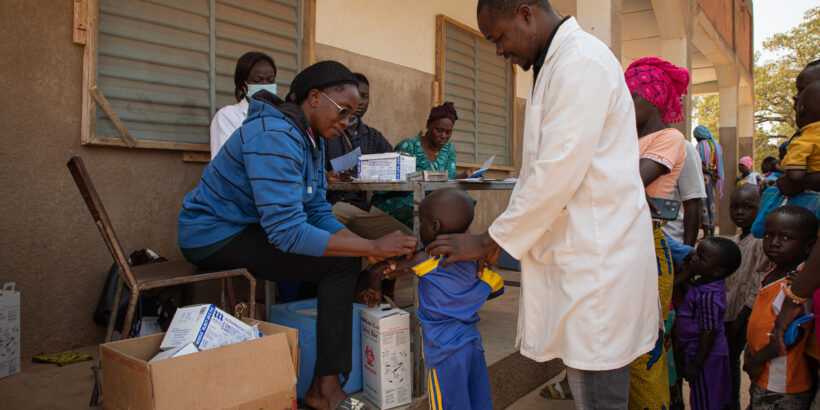In January 2025, Burkina Faso introduced typhoid conjugate vaccines (TCVs) into its national immunization program, vaccinating more than 10 million children across the country through a nationwide campaign. As part of the decision-making process, Burkina Faso considered data on typhoid burden: a critical metric for any country considering TCV introduction.
Dr. Lassané Kaboré, Senior Program Officer for Evaluation and Learning at Gavi, the Vaccine Alliance, supported data collection and introduction efforts in numerous African countries while working as a Senior Program Officer at PATH. Lassané shared how PATH, a core partner of the Typhoid Vaccine Acceleration Consortium, worked with local hospitals, labs, and research institutes in Burkina Faso to gather a broad set of data on typhoid burden in the country.
This interview has been edited for length and clarity.
Can you tell us about your experience with typhoid and TCVs? How did you come to work in this area?
I started working on typhoid and TCV introduction when I joined PATH in 2019, and I supported introduction efforts in Burkina Faso, Liberia, Malawi, Niger, and Zimbabwe. I also supported decision-making in several other African countries that have not yet proceeded to the final decision to introduce TCV in their routine immunization.
Why is it important to understand typhoid disease burden?
Disease burden and its distribution among various age groups is a critical data point to decide if a given country should introduce a new vaccine, and how that vaccine should be used—the target age group, for example. This is more and more important as countries are trying to address several health problems at the same time, and therefore they have to prioritize where limited resources should be spent.
How do you coordinate among different stakeholders in the data collection process, from local researchers to the Expanded Programme on Immunization (EPI)?
In the case of Burkina Faso, we initially formed a working group with partners that we knew were doing typhoid and TCV work, whether research or technical assistance, under the guidance of the EPI manager. As typhoid data tend to be scattered across several health establishments throughout the country, like hospitals, labs, and medical research institutions, I worked with the Ministry of Health (MOH) and other partners to organize a national forum on typhoid. During the forum, held over two days, we invited representatives from several labs, research institutes, and hospitals to present their data on typhoid. This helped bring partners together to build momentum for typhoid control prioritization.
We then developed a technical report summarizing the data presented during the forum. Subsequently, the EPI shared the report with the National Immunization Technical Advisory Group, which eventually recommended TCV introduction after considering other types and sources of data.
The data that we have on disease burden isn’t perfect. How do you know when there are sufficient data to clearly show typhoid burden?
Typhoid disease burden being imperfect, decision-makers should consider several data sources, and triangulation can help visualize a more comprehensive picture of the situation. For instance, in the case of Burkina Faso, we used various data sources, including:
- Incidence data obtained from a longitudinal population-based surveillance study from one region of the country.
- Suspected typhoid cases over several years obtained from the national health information system.
- Drug resistance data obtained from hospitals and research labs.
- Intestinal perforation data identified by surgeons working in a few hospitals.
Taken together, these data demonstrated significant typhoid burden and supported the country’s decision to introduce TCV.
What challenges did you face with consistent data collection during periods of political turmoil and other disruptions in Burkina Faso, and how did you overcome them?
The decision-making process in Burkina Faso was mostly delayed by the COVID-19 pandemic, and less so by political disruptions. This is because the stakeholders involved at the MOH are technical officers who are less likely to be affected by political changes than governments or regimes. It is important to remain persistent, relentless, and patient with MOH counterparts, as they have many competing priorities. In so doing, a few windows of opportunity appeared that we were able to leverage to advance TCV discussions.
The work you did to collect and share typhoid burden data supported Burkina Faso’s evidence-based decision to introduce TCV, which happened in January. What was it like to see that campaign roll out?
I have a personal connection with typhoid; in 2007, I lost a young sister who had just completed primary school to typhoid-related surgery complications. I couldn’t therefore be happier and prouder to see that the work I contributed to in Burkina Faso came to fruition, and that children will now be protected against this disease, thereby averting countless unnecessary or premature deaths.
As one could guess, I made sure that my three children aged 6, 10, and 13 received their TCV shot!
Cover photo: A child receives TCV during Burkina Faso’s introductory campaign in January 2025. Credit: TyVAC/Build Africa Communications



